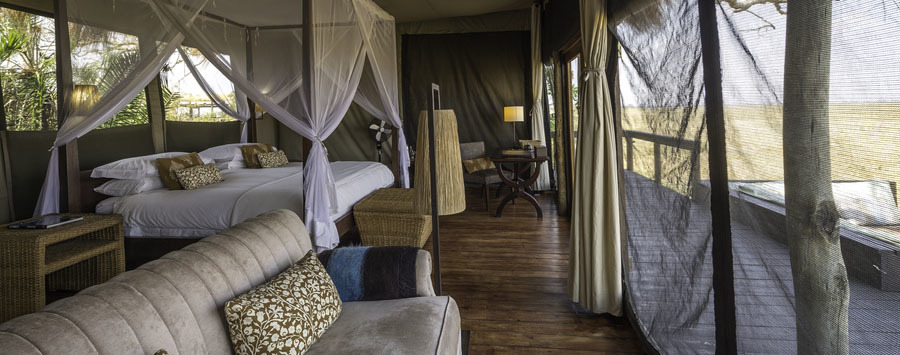Safari Planning

Africa has hundreds of safari camps, ranging from mobile canvas tents that sit on the ground to massive, glass-walled suites perched atop wooden platforms connected by raised boardwalks. With such a broad range of options, we've identified three key factors to choosing the camp that is right for your safari experience:
1. Tented Camp or Lodge
By "tent" we're typically describing a tented suite with an attached bathroom. One of the greatest benefits of tented camps is that they allow your senses to fully engage with nature. Lying in your bed at night, you'll hear lions roaring a few miles away and hippos barking their distinct calls, all from the comfort of a plush, warm bed. Fresh air and the aroma of wild plants filter through tent walls made of canvas and mesh. Tented camps can range from mobile style walk-in tents to spacious canvas and thatch suites built on wooden decks with wood-framed doors, all of which are plumbed with hot running water and flushing "loos."
Brick-and-mortar lodges can also feel entwined with nature and often include air conditioning, heat, fireplaces and other comforts not generally available in tented camps. Lodges are ideal for particularly hot or wet times of year, when an extra barrier to the elements might be desirable. They are also a good option for families traveling with children. Lodges can range from simple and stylish rooms to luxurious free-standing suites with private pools, sometimes rivaling the size of an average single-family home!
Insider Tip: Choosing a lodge that features traditional thatched roofs and doors that open to a spacious, private outdoor area adds a deeper sense of connection to being in Africa. Select smaller camps and lodges with 12 or fewer rooms for a more private experience.
2. National Park or Private Reserve
Sometimes, staying inside the national parks is the only way to immerse yourself in a particularly spectacular wildlife marvel. For example, seeing thousands of wildebeest crossing the crocodile-filled Mara River during the great wildebeest migration can only be experienced inside the Maasai Mara or Serengeti National Park. You will see other vehicles and travelers, but you are witnessing a phenomenon unique to these locations. The Ngorongoro Crater is a busy site, but it remains a must-have experience for most travelers to Tanzania. By contrast, Zambia’s and Zimbabwe’s national parks of are often less crowded and offer prime wildlife viewing while remaining inside the parks.
In other areas, such as South Africa's Kruger National Park, you may want to stay outside the park with its paved roads that are open to day-trippers and self-drivers. Consider a private reserve instead. Private reserves offer flexibility, exclusivity and additional activities that are impossible within the boundaries of national park rules. Nighttime wildlife drives, guided nature walks and off-road adventures are typical benefits enjoyed on private reserves, experiences generally not allowed in most national parks. Guest numbers are kept low in the private reserves, often with only two to three vehicles allowed at a wildlife sighting. Taken all together, the advantages of a private reserve offer a sense of exclusivity and heightened engagement with the African safari experience.
3. Activities
Most safari camps focus on wildlife drives in 4x4 Land Cruisers or Land Rovers, the best way to get close to large animals like elephant, lion, buffalo, rhino and giraffe. But some camps offer additional activities to diversify your experience. Guided walks may take in smaller elements of a habitat—plant life, small reptiles, birds and even animal droppings can teach you a lot about an area you're exploring. In some private game reserves, tracking rhino and cheetah on foot is an exhilarating and energizing alternative to viewing animals from an open vehicle. Several Botswana-based camps feature mokoro (traditional dugout canoe) floats as well. A guide stands at the back and propels the mokoro by pushing a long pole off the shallow bottom of the Okavango Delta. Many camps in Kenya, Tanzania and Namibia feature the option for hot-air ballooning over some of Africa's prettiest landscapes. Other scenic flight opportunities include bi-planes, helicopters and even micro-light aircraft.
Call Us for a Free Proposal – 1-800-543-8917
| Click Here to Email a Safari Specialist |
Image © Dana Allen
